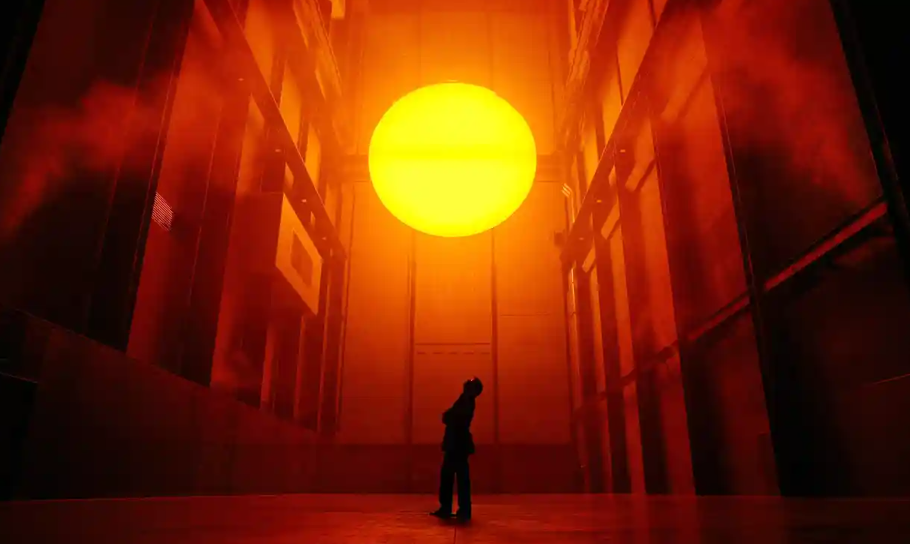Smriti Malhotra
Imagine walking towards the sun in a large hall in a renowned art gallery in London, how would that make you feel? You may have walked into a gallery to see art in its conventional form, however, you’re greeted with a sunset.
The orange and yellow light emitted from the gigantic circular installation would create a unique immersive experience for any visitor. In this essay, we shall be looking back at Olafur Eliasson’s The Weather Project which was sponsored by Unilever, the world’s largest consumer goods company. The Scandinavian artist constructed this installation at the Turbine Hall of The Tate Modern in the year 2003.
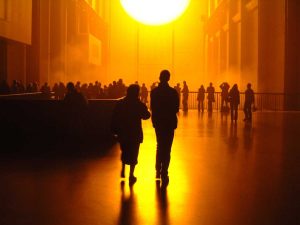
Eliason has explored 3 separate topics in this installation, experience, mediation and representation also juxtaposed in relationship with the weather. Eliason in the catalogue for the exhibition writes “It is commonly observed that when two Englishmen meet, their first talk is of the weather; they are in haste to tell each other, what each must already know, that it is hot or cold, bright or cloudy, windy or calm. Eliasson nudges us to think about our respective relationships with the weather, to identify memories and moments of our interactions with the weather and how that made us feel.
This installation created an environment that enveloped its visitors in a unique sensory experience. The installation was designed to transform the vast, industrial space of the Tate Modern’s Turbine Hall into a warm, inviting environment that encouraged visitors to engage with their surroundings. The use of light was a key component of the installation’s immersive qualities. The glowing sun was created through the use of hundreds of lamps, which bathed the space in a warm, orange-yellow light. The mirrored ceiling reflected this light, creating an illusion of infinite space and amplifying the immersive effect.
What was truly special about this installation is that it encouraged visitors to experience the “sun” and its warmth collectively and as a community. Olafur Eliasson in conversation with Tate in their youtube video TateShots, states that collectivity plays an important role in his work and that the weather project has a significant relationship with the collective experience.
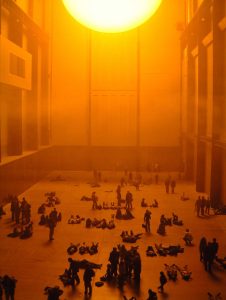
The Turbine Hall was transformed into a public space with visitors flocking in and lying down on the floor for hours experiencing this installation and “weather”. Visitors were seen interacting with each other and art in a new manner which wasn’t seen as though before at the Turbine Hall. Olafur Eliasson in an interview with Tim Jonze for the Guardian said that he was surprised to witness people become physically explicit at the show, they were lying down, rolling around and waving. There were yoga classes, cults and protests happening at the show which surpassed his expectations.
The installation challenged traditional notions of art as a static object to be viewed from a distance and instead invited visitors to become active participants in the artwork itself. This is what made the Weather Project one of the most popular installations ever in the history of Tate Modern, drawing over two million people in the six months run. It is widely spoken about installation acclaimed for its light and space usage and its ability to create a sense of community and togetherness in a somewhat “elite” structural space.
However, the frustration about this installation like these is the exact themes it stood for, it is nearly impossible to know it in pictures, videos and even testimonies of how good it would have been. To witness it yourself and being there physically can be the only way of experiencing something as beautiful and wholesome.
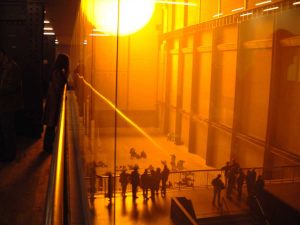
This entire work was based on a sensory illusion, the ceiling was lined with mirrors to give the illusion of an elongated height of the structure, and the haze and fog were pumped into the hall to provide an essence of atmosphere. Visitors could see how this installation was made and the sun was constructed, they knew very well of this elaborate illusion that they were a part of. Eliasson states, “ By walking to the far end of the hall, the visitors could see how the sun was constructed, and the reverse of the mirror structure was visible from the top floor of the museum.” Eliasson wanted the viewers to know that they were being deceived and to be aware of the surroundings they were a part of. 20 years have passed since this iconic installation, however, the effect of this exhibit was unlike any other in the history of the art world.
Eliasson has always challenged the viewers to connect and question the art that they may be seeing, to be aware of their surroundings and yet immerse themselves in the art. He frequently showcases the relationship between man and the natural world through his work, such as For ‘Ice Watch’(2014), he left giant blocks of glacial ice to melt in London, Paris, and Copenhagen. Twelve large ice blocks were installed in public spaces, drawing attention to the impact of climate change on the Arctic. In ‘Waterfall’, he created a massive waterfall that cascaded down the side of a building in the heart of New York City. The installation challenged viewers to consider the relationship between nature and urban environments and to reflect on the power of water as a force of both destruction and renewal. Another notable example is Eliasson’s “Green River,” installed in various locations around the world. This work involved colouring the water bodies bright green suggestive of decay and rotting, reflective of the ways in which human activities can impact the natural world.
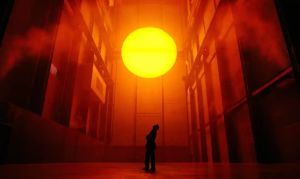
His work has often blurred the boundaries between art and the natural world. By using natural elements in his works such as blocks of ice, water, stone and wood, he challenges the viewers to look beyond the surface and the material of the work and to contemplate the deeper connections that exist between humans and the environment. The natural world is a forced to be reckoned with and he often leaves his viewers/spectators evaluating their existence within the larger natural habitat.

